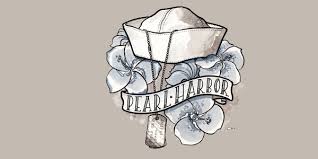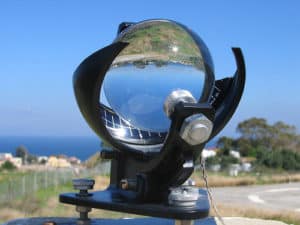 December 7, 2018 marked the 77th anniversary of the Japanese attack on Pearl Harbor which led to the United States’ entry into World War II. The US involvement started in 1941 and lasted until the end of the war in 1945. According to US Department of Veterans Affairs statistics, 496,777 of the 16 million Americans who served in World War II are alive in 2018. We are losing 372 veterans per day.
December 7, 2018 marked the 77th anniversary of the Japanese attack on Pearl Harbor which led to the United States’ entry into World War II. The US involvement started in 1941 and lasted until the end of the war in 1945. According to US Department of Veterans Affairs statistics, 496,777 of the 16 million Americans who served in World War II are alive in 2018. We are losing 372 veterans per day.
My 96-year-old father-in-law, Bill, is one of the surviving 496,777 WW II veterans. Although he now sometimes forgets little things, he does remember Pearl Harbor and D-Day vividly. He was not in the military at the time of the attack on Pearl Harbor, but he had a vital part in D-Day (June 6, 1944), the day when allied forces invaded northern France by means of beach landings in Normandy.
Bill was a Seabee and responsible for the barges that were put up on the beach to form landing causeways. Food, tanks, medical supplies, ammunition, tanks, etc. were delivered for days, weeks and months before the invasion. The Seabees periodically dove for cover as they were targeted by enemy machine and artillery fire. He witnessed the invasion on June 6th when “soldiers were mowed down and losses were high.” He, himself, was treated for shrapnel wounds. The invasion was one of the largest amphibian military assaults in history and required extreme planning. It was the beginning of the end of the war in Europe.
This summer Bill was visiting us from Florida at the same time as my 10-year-old grandson, Kye, had traveled up from Oregon. One day I found Bill on the sofa telling Kye about his wartime experiences. My daughter had the foresight to video tape the conversation, which was more of a monologue with Kye interjecting questions every now and then. What a history lesson for a 10-year-old boy!
For those children or young adults who are not fortunate to have a great-grandfather to tell the eyewitness tale, there are books that will suffice.
Children’s books, “What was Pearl Harbor?” and “What was D-Day?” by Patricia Demuth, present an easy to read narrative with pictures of the actual events. Elementary school children will find these interesting to read. “True Stories of D-Day” by Henry Brook tells true stories of heroism and drama told by men of different nationalities who took part in the invasion. It is a book appropriate for junior high or high school students. The stories are written so that the violence of war is not emphasized.
For adults, the best book I have read about the attack on Pearl Harbor is “All the Gallant Men: An American Sailor’s Firsthand Account of Pearl Harbor” by Donald Stratton. It is a powerful memoir of the day Stratton, then a 19-year-old Seaman, was aboard the USS Arizona when the explosives below his battle station ignited during the Japanese air attack. He was burned over two-thirds of his body, but he miraculously survived by hauling himself hand over hand across a rope tied to a neighboring ship.
Stratton begins his story by telling of his modest Nebraskan beginnings during the Great Depression and the lure of the Navy for a steady paycheck and a view of the world. After basic training in September, 1940, he was assigned to the battleship USS Arizona and sailed into Pearl Harbor. His job aboard the ship was to operate the five port-side antiaircraft guns and that was where he found himself at the beginning of the attack on Pearl Harbor. He found the exercise futile since the dive bombers were too low for their guns and the horizontal bombers were too high. He fired aimlessly until they were out of ammunition and a final blast to the ship made him find his way through the smoke and fire to grab a line and haul himself to safety on the neighboring vessel.
Strafford’s keen memory of all that happened leading up to, during, and after the Pearl Harbor attack is extraordinary, especially since he wrote this memoir at the age of 94. Reading it is like viewing a movie as the action unfolds.
Especially interesting are Strafford’s reflections and analyses of the event in a historical context. His views of what went wrong included 4 premises: we lacked foresight, we communicated poorly, we were overconfident and we were not alert. He even explains a parallel between December 7, 1941 and September 11, 2001.
A comprehensive reading of D-Day is the book, “Voices of Valor: D-Day, June 6, 1944” by Douglas Brinkley and Ronald J. Drez. This book includes 2 audio CDs with oral histories from D-Day veterans, and many pictures amidst the detailed historical text.
For the United States, World War II lasted almost 4 years. The attack on Pearl Harbor and the D-Day invasion are vastly written about and studied in American History. As with all life changing historical events, we must not forget them.
In Donald Stratton’s words, “The great lesson we too often learn from history is that we are so prone to forget the past. And there is a price we pay for our forgetfulness.” I am sure my father-in-law would agree.
Norma Logan is the Literacy Volunteer Coordinator at the Morrill Memorial Library in Norwood, MA. Look for her article in the December 13, 2018 edition of the Norwood Transcript and Bulletin.




